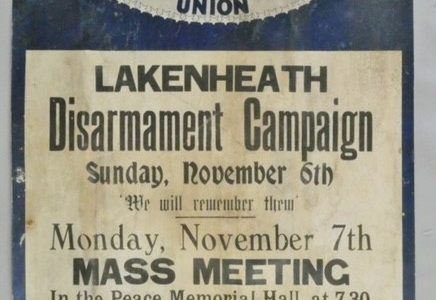
The Lakenheath Peace Poster and the Lakenheath Branch of the British League of Nations
Guest post by David Jones (Lakenheath Heritage Group)
This is an account of how an historic poster came into the possession of the Lakenheath Heritage Group, and the impetus it gave to discovering the village’s involvement with the British League of Nations Union and the interwar peace movement. The poster is now preserved at Cambridge University Library (shelfmark Broadsides.AA.9.61). We first heard about the poster a few months before the beginning of the Covid 2019 pandemic not long after we had added a story to the heritage pages of our Parish Council website about the experiences of a villager, Henry Flatt, at the Battle of Ypres. Shortly after we included a newspaper article from 1927 reporting on a meeting in the village which had led to the formation of the Lakenheath Branch of the British League of Nations Union. This prompted a villager to tell us about “an old poster in my friend’s shed” which had been discovered in the 1980s by Peter and Pat Hale when they purchased their house in Broom Road from a Major Popay who had lived there with his wife Jessie (d. 1963) since 1925. Jessie was the grand-daughter of Dr Pickworth, the long-standing village doctor, who had played an important part in the local branch of the League of Nations Union.[i]
When, years later Mr. and Mrs. Hale downsized, ownership of the house was transferred to their daughter but the poster remained in the shed until, in recent times, the need for storage space led to its rediscovery. The poster had to go and the ‘tip’ or the bonfire beckoned! After the Covid pandemic Mr. and Mrs. Hale gave the poster to the Heritage Group and our research into the Lakenheath League of Nations Union branch continued. The poster measures 765×500 mm and may have been one of a small batch but as far as we know no others exist. The printer is not identified. The pandemic gave us time to consider what should be done with what we thought was an interesting survivor. We sought the advice of Nicholas Burnett of Museum Conservation Services Ltd, who after examining the whole thing including the timber planks, told us that conservation was possible.[ii]
We thought that the boards on which the poster was fixed could have been a shop-window shutter, but more important was the idea that the faint scratch marks appearing to deface the word ‘disarmament’ might suggest some opposition in the village. After some heart-searching the group took the decision to proceed with the conservation of the poster which was made possible by an anonymous donation supported by our own funds. Nicholas Burnett carried out the work. This included removing drawing pins, gentle cleaning, removing the poster from the board and removing old adhesive, before re-lining with Japanese paper, infilling losses with wove paper and recreating missing lettering with watercolours. Part way through the conservation process we contacted Cambridge University Library to ask for advice about finding a future home for the poster.
Lakenheath Branch of the League of Nations Union
The Bury Free Press newspaper (henceforth BFP) provided the first indication of the beginnings of the peace movement in the village in an article from 19 November 1927 which recorded a well-attended meeting. This added to what we knew about some prominent village inhabitants. Alderman Lusher, representing the League of Nations Union, said that:
“He was delighted to see such large number of young people present … perhaps the most notable feature of that recent observance (referring to the recent anniversaries of the Armistice Day) was that little or nothing [was] heard of the rejoicing and exaltation which marked the advent of the Armistice in 1918 … people were asking whether we were paying our debt to those who laid down their lives in that great struggle by doing all we can to make another war impossible.”
Given the high casualty rate suffered by the village in WW1, was the meeting arranged thinking that the village might be fertile ground?[iii] It certainly marked the beginning of the Peace Union in Lakenheath.
“A gratifying number of members came forward at the conclusion of the meeting, and under the chairmanship of the Vicar, who evinced great keenness, discussed the appointment of an official in forming a branch of the Union for Lakenheath.”
By 1928 the local branch was active.[iv] Further newspaper articles reported the successes of the local branch; one suggestion was that the formation of a junior group be considered. The AGM of 1933 recorded that there were 114 registered members and that there had been seven meetings in the year. Funds from the annual national membership fee (1/-) were £11.16 shillings (BFP, 25 March 1933).
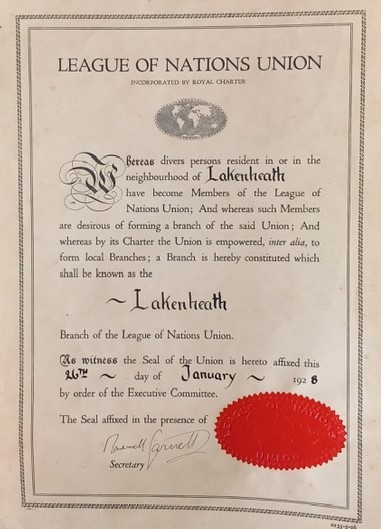
The Disarmament mass meeting of 1932
By 1932 the group was well established. Ambitions were high and a mass meeting was planned to encourage understanding of the issues facing the country and a hope that a commitment to the disarmament cause advocated by the League of Nations would be strengthened. The first indication of the 1932 disarmament meeting came in an article in the BFP, discovered shortly after our first sight of the poster. This named Henry Flatt as the first speaker, and directly linked the poster with his experiences at Ypres and his involvement with the peace movement in the village. Also identified were other ‘prime movers’ in the group, the long-standing village doctor, the vicar and a local schoolteacher.[v]
The discovery of the 1932 report was something of a light-bulb moment, providing a date which supported earlier local research which had provided us with a copy of Henry Flatt’s observations of Ypres together with notes he made for a talk he was to give. Our problem previously had been that we knew what Henry wanted to say but not when or where he wanted to say it! The article resolved these questions. Henry became an important member of the local League of Nations Union group. His fears of aerial bombing and the use of gas as a weapon are clear from this partial transcript from Henry Flatt’s Ypres notes from 1918:
“The air was stuffy with sodden clothing and humanity unwashed. The Calvary of Ypres. Honey-combed putrid matter for honey. Swept by machine-gun fire and rifle fire then shelled. Terrifyingly we wondered if anything can possibly survive, then stormed by Phosgene, its pear and apple stench or perfume dulls the senses, men almost forgetting its horrors and delay. Then, maddened by the poison they would hurry to their ‘posts of battle for civilisation,’ the aid post or canteen, there they would stagger as the blood diffused phosgene through the system and with a cigarette they sink down. Retching-dying, gassed. The Calvary of Ypres … May the God of Peace keep me from a like experience.”
… and from this edited extract from his notes for a talk:
‘We had just moved into a camp behind Ypres. In fact, there were general camps round about where troops came to rest, usually there is a few farms about and the people do a good business in supplying coffee, egg and chips to the troops … One evening 3 or 4 others and myself decided we would go out to supper. We were just enjoying the good things when we heard the drone of a plane, next thing horrors, bone cracking, doors bursting open, women shrieking and a ‘funeral hot-bath.’ Jerry had dropped one in the yard. We heard some dropping in our camp so hurried along as the order was, “All men to rush to their vehicles and stand ready with fire extinguishers.” We mingled with the crowd and answered the role-call.’ (Lakenheath Heritage Group: Timeline Part 5. 1912. Henry Flatt and his Family).
The success of the occasion seems to have further energised the group and was followed up with meetings and lectures by the Vicar, Dr Pickworth and Henry Flatt on a range of topics such as ‘The Necessity for an International Labour Organisation’ (Dr Pickworth, with the lantern manipulated by Mr. H Flatt: Newmarket Journal and Free Press (henceforth NJ), 21.01.33), ‘Bacteriological and Chemical Warfare’ (Henry Flatt, delivered by the vicar in Henry’s absence due to illness, and ‘The Cost of the League’ (Dr Pickworth: BFP, 21.10.33). It does look as though the Lakenheath Group were preparing the ground for the approaching national Peace Ballot.
The Peace Ballot 1934-35
The National Declaration, sometimes called the Peace Ballot, was an attempt by the British League of Nations Union to determine public opinion regarding the aims of the League of Nations as they particularly related to Great Britain. It took place between November 1934 and June 1935 and is often regarded as the country’s most successful unofficial referendum. The Lakenheath branch started to prepare in earnest. The BFP issued an invitation “to come and hear it (the National Declaration) described at the Peace Memorial Hall” (BFP, 17.11.34), and the Lynn Advertiser (henceforth LA) followed with “In Lakenheath Rev. Isaac Morris gave an address on the National Declaration at a special meeting” (LA, 23.11.34).
A public debate followed with Dr Pickworth proposing, “That Great Britain should remain a member of the League” with Henry Flatt, (standing in for Dr O’Leary), countering. The proposal was carried but there was no mention of the numbers attending (LA, 21.12.34 and BFP, 22.12.34). Early in the New Year, a sermon by former minister Rev A E Middleton in support of the National League was given in the Methodist Church, “And man at war with man hears not the love song which they bring” (LA, 12.01.35). The result of the ballot was declared in June.[vi] In September the local group discussed the Abyssinia/Italy confrontation questioning, “What should happen if Italy refuses to accept the League’s recommendation?” (BFP, 28.09.35).
The discovery that the 1935 AGM of the much larger Bury St. Edmunds branch (BFP, 01.06.35) had suggested that the failure of Italy and Abyssinia to accept arbitration was a reason for a reduction in their membership led us to look for signs of a similar reduction in Lakenheath. Newspaper evidence was soon found.
Decline?
There seems to have been a question regarding the future of the Lakenheath group at the September 1936 meeting after which it was reported that a decision had been taken to continue. Mr. J E Goudge, travelling secretary of the Union, had addressed the meeting (LA, 26.09.36). A contrary voice was heard in the village! At the New Year’s Dinner of the Lakenheath Conservative and Unionist Association in January 1937, Captain F. F. A. Heilgers, MP for Bury St. Edmunds, commenting on the past year from an agricultural standpoint, also expressed his views on the reducing (declining?) influence of the International League.
“They had seen the League of Nations, on which they had placed their faith and regarded as a pillar of security, prove to be but a frail reed when the time came. Later in the year they saw the Germans march into the Rhineland and again were very nearly involved in a European war. Still later there came the Spanish civil war and that, far from being a Spanish internal struggle, had magnified until today he believed Spain has become the cockpit of Europe.” (NJ, 09.01.37)
The members of the Lakenheath Group must have been aware of Capt. Heilger’s views as their activities continued in the New Year with a meeting which heard about the International League’s work to stamp out illegal drug traffic and the prevention of outbreaks of disease in Spain. £2.2s was to be sent to the fund for refugee children in Spain (BFP, 30.01.37). However, a fall-off in support is again suggested by the AGM in April 1938 when discussion focused on how the group might be strengthened. The Chairman (the vicar) pointed out “that although the League itself had not yet succeeded in carrying out its ideals the chief aim of the league of Nations is to keep those ideals in the minds of the people” (BFP, 02.04.38).
A decision was taken to hold a public meeting in the early autumn but no evidence has been found that this took place and a later article reported a meeting at the vicarage at which a guest spoke about the ‘state of affairs’ in Austria and Czechoslovakia (LA, 01.07.38). This is the last reference we have found to the Lakenheath Branch of the League of Nations Union in the press. The developing international situation may have led to some tension in the group and a questioning of ‘what have we achieved?’ Perhaps, ‘was it all worth it?’ I wonder if they knew what had happened at Guernica?
The shed in Broom Road?
So why was the poster kept, how did it end up in the shed, being ‘shifted’ out of the way and then forgotten? Was there regret at the demise of the local group which led to a determination that the poster should survive as evidence of what had been achieved, a sense of ‘history’ and a pride in what had been done? Or was it simply a personal whim?
We imagine that the poster was ‘rescued,’ but by whom? The possibilities are numerous, leaving us with not much more than guesswork. Was Dr Pickworth’s grand-daughter Jessie involved? Did her husband simply put it in the shed? We have absolutely no evidence for either, or indeed anything else! In the end, the poster was simply put out of the way and ultimately forgotten until happily it emerged in 2019.
Sources and references:
Popay family. Bury Free Press. Prof. Raymond Bonnet.
50 Facts and Figures about the League of Nations. Third Edition circa 1936. George Innes. Pub. League of Nations Union. London Regional Federation.
Votes for Peace. The National Archives: The report to the Prime Minister and Secretary of State for Foreign Affairs. July 23 1935. (PREM 1/178). App. 6.Lakenheath Heritage Group. The Henry Flatt documents. (Copies). His notes made shortly after Ypres and his preparatory notes for an address.
[i] In 1925 Percy and Jessie Popay came to live in Jessie’s home village in a house on the outskirts of the village. Jessie, grand-daughter of the influential village doctor, Dr Pickworth, worked at the War Office in WW1. After the war she taught at Livermere School, Bury St. Edmunds. She died, childless, in 1963. Percy continued to live alone in their home until it was sold in the early 1980s. Percy was wounded at Passchendaele and remained in the army after the war. At the beginning of WW2 he was commissioned, eventually achieving the rank of major, leaving the army in 1953 having served in the British Army of the Rhine. In later life he was an active member of the parish church (Secretary of the PCC) and served on a several local committees, particularly the Peace Memorial Hall and the local branch of the British Legion. The PCC placed a window to his memory in St. Mary’s Church Parish, Lakenheath.
[ii] ‘Condition: Solidly adhered to an old door composed of three vertical tongue and groove planks (which have woodworm). The poster is badly damaged where it was unsupported along the gaps in the support. This has divided the poster into three vertical sections. More than twenty losses of paper have occurred, several very large ones along the gaps in the support. The poster is discoloured, water stained and abraded. The surface is dirty and spotted by mould.’ A cross has been cut in the surface through the word ‘Disarmament.’ This is clearly part of the history of the poster so needs to remain visible after treatment. Drawing pins were used to hold another poster over the front of this one at a later date. Only traces of paper now remain held by the pins and the pins are now rusty. This may affect the poster beneath.’ Nicholas Burnett. Museum Conservation Services Ltd.
[iii] Lakenheath suffered grievous losses in the war; a very rough estimate based on those liable for conscription from the 1911 census suggests that around 24% did not survive. It has been said that there were “a lot of aunties in the village.” By 1922 the village had raised sufficient funds for a war memorial and a village hall (to be known as the Peace Memorial Hall).
[iv] The committee was made up of widely respected inhabitants who were prominent in church and local civil life – Miss Moore, Rev Isaac Morris, Dr Pickworth and others, but notably, Henry Flatt. No minutes from any meetings have been found.
[v] Dr Pickworth was the village doctor for the whole of his working life from 1884 to 1923, dying here in 1943. Greatly respected in the village, he was well known in the Methodist movement and a lay preacher of some note, Justice of the Peace, consultant surgeon to the Mildenhall Union (workhouse), County Alderman, Life Governor of Addenbrookes Hospital. He also made fireworks for village celebrations. Henry Flatt (d. 1977) came to the village circa 1904 with wife and two, later three, children. Previously employed as a groom in to a wealthy family, he came to the village as an insurance agent and later began renting bicycles, mainly to farm labourers. Conscripted in WW1 aged 35 with a wife and three children, after the war he continued to expand his enterprises eventually providing the first taxi in the village as well as his unique concept of a village shop, bicycle sales and repairs and a garage. He then became the largest chicken farmer in the district. In WW2 he was a special constable and later a parish councillor. Miss M. E. Moore taught at Lakenheath school and was a pillar of St. Mary’s Parish Church. Regarded as extremely efficient and an authority on church matters, she was secretary to the local branch of the League of Nations Union. We are told that she died in a road accident in the village in the 1950’. Rev. Isaac Morris was an influential and well-liked vicar of Lakenheath from 1919 until 1939. Dr M. O’Leary worked as the village doctor for nine years leaving in late 1937. Rev J Lewis appears only occasionally in press reports and not after the 1932 meeting.
[vi] 11.5 million votes were cast out of a possible 30 million with 13 to 1 in favour of support for the League of Nations and 3 to 1 in favour of the use of military sanctions. The majority for the total abolition of military and naval aircraft was 4 to 1. See sources.

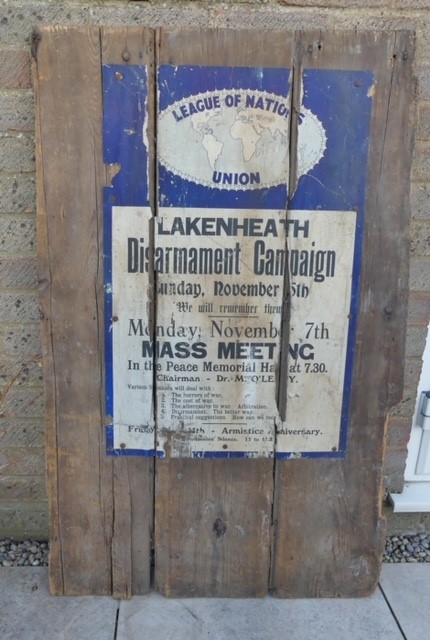
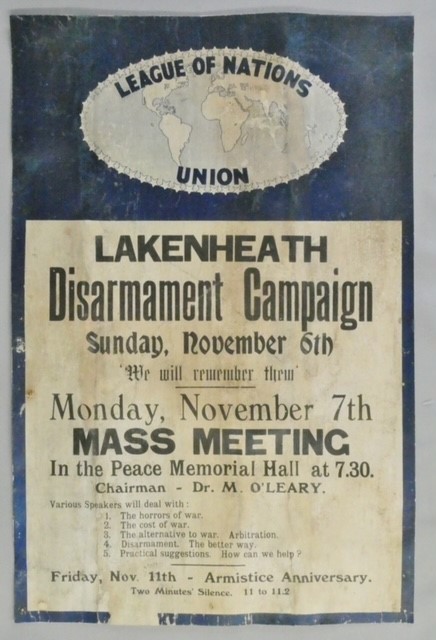
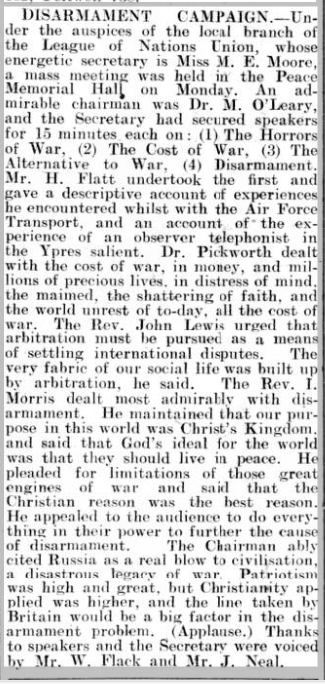
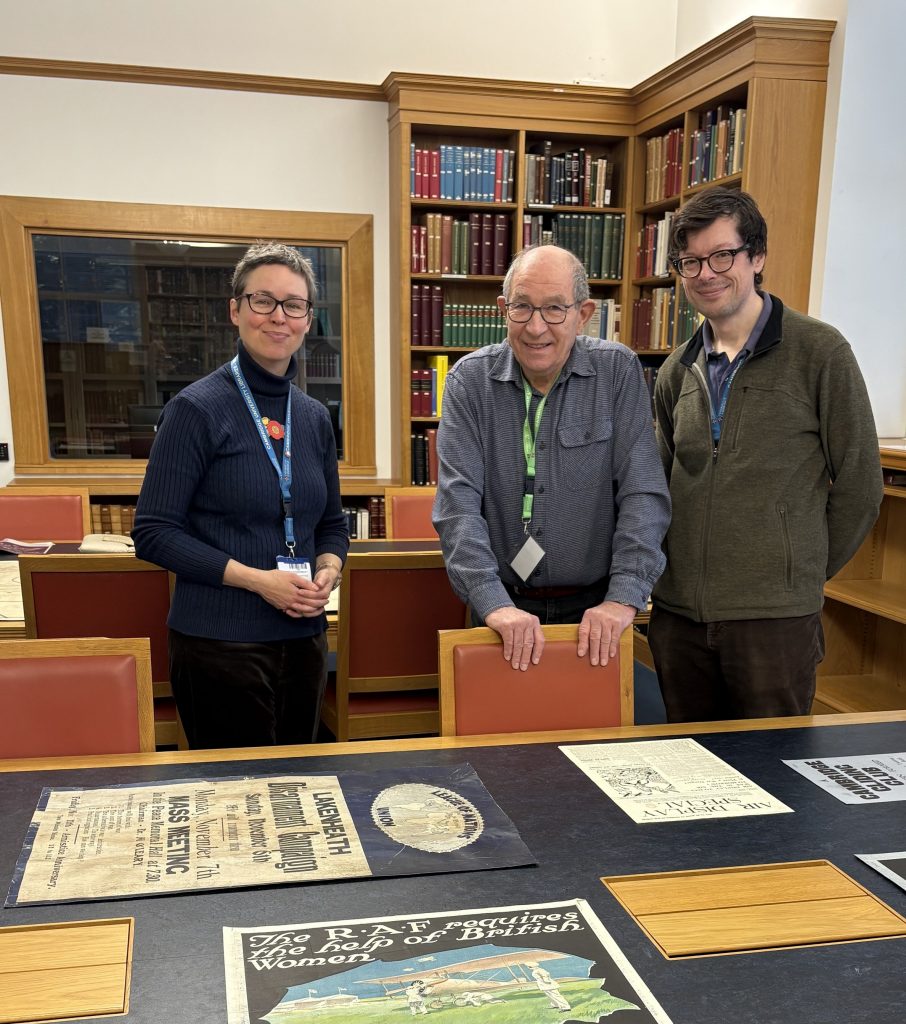
A thoroughly researched piece of my village history, quite superb. I wish my mother and grandmother were here to comment.. Alas no.
Thank you Edward!